|
Fredericksburg, VA likes beer.
Many at Oktoberfest visited other businesses
"............... About 10,000 people attended the
fourth-annual Oktoberfest put on by Capital Ale House. A fifth event
is planned next year, assuming the city approves
it.......................
Among the other findings in Gold's survey were: Only two
people said they encountered any issues with security. Eleven
people said the wait times to get food and a drink or enter the
event were too long. Just three people described their parking
experience that day as "difficult." Almost everyone
surveyed said that they had visited downtown Fredericksburg
previously, and that they planned to return downtown.....".
Bill Freehling: 540/374-5405; Email:
bfreehling@freelancestar.com; 10/19/2012
Source:
Free Lance Star newspaper and Fredericksburg.com
online
Click
HERE for the full story from the Free
Lance Star newspaper
PRICE: $395,000; price subject to change without notice.
___________________________________________________________________________________________________________

Why ?
Why should the
Ice Plant become a
Microbrewery?
OR
A brewpub?
OR
A brewery Co-op
at left, photo of Old
Dominion Brewery, one of the best.
A microbrewery in
Fredericksburg (the Burg):
Fred
Brew or Brew
Fred ?
Brew
Burg or Burg
Brew ?

_____________________________________
Microbrewery is generally applied to craft beer makers; they are
generally small (under 6 million barrels a year), independent, and
Traditional (see article at end of this web page).
Brewpubs generally have a microbrewery on premises, are
small, and serve food and/or provide entertainment.
Brewery Co-op is a relatively new concept whereby several
small craft beer makers and/or serious hobbyists will use one facility,
thereby lowering overhead costs for all. A very good article from
the Washington Business Journal about a facility in the Baltimore, MD
market is found at this hotlink:
Click
HERE
for a link to the Washington Business
Journal news article
Ice Plant: Building and grounds
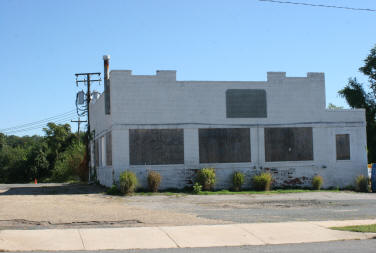
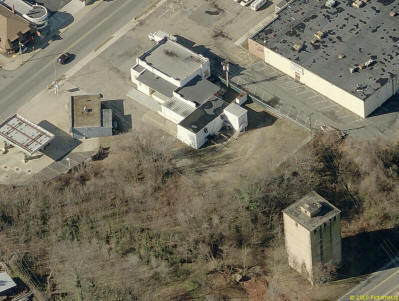
Existing ASSETS at the
Ice Plant
·
Three phase heavy electric;
·
Natural gas;
·
Cold box storage existing of about 2,300 sq. ft.;
·
A brick building with bare brick walls; ceiling
height of about 18 feet in most of the building (after removing part of wood
floor);
·
Aesthetics and moral sensibilities of recycling
(adaptable reuse) a brick building circa 1940’s;
·
About ¾ an acre in the City of Fredericksburg;
·
Off street parking;
·
Zoning of mostly CH, Commercial Highway; Zoning
Dept. stated the use is by-right for a microbrewery and/or brew pub, per
conversation with zoning department;
·
Zoning allows for up to 40 feet in height, a
phases approach might result in a second phase going vertical with a beer garden
on the roof of a second or third story, overlooking the huge park, trail, and
river at the Caroline Street elevation
Click
HERE
to go to the page with detailed
information on the Ice Plant
 At left, Williamsburg Ale Works; a tour taking place
At left, Williamsburg Ale Works; a tour taking place
Ice
Plant Location:
·
Located on Princess Anne Street, in the City, near the historic district, very
close to and backing up to the 1.5 mile hiking/biking trail;
· The site is in a HUB ZONE, Tourism Zone, and Technology
Zone;
· The site is located next to the “Old Mill” historic
district;
· The site is somewhat between the Route 1 (north/south)
and Route 3 (east/west) bridges over the Rappahannock, making access very
strong to the region;
· Census 2010 data from ESRI: 46,212 in a 3 mile ring;
83,397 in a 5 mile ring; 191,148 people within a 10
mile ring of subject;
· Accessible within north/south and east/west axis of
existing road networks and settlement patterns;
· Princess Anne Street is identified in a number of City
of Fredericksburg planning documents as a gateway corridor (Route 1 was main
street); this section of Princess Anne Street is identified as a prime area
for redevelopment;
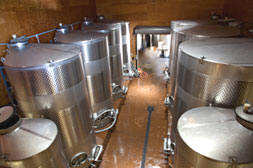 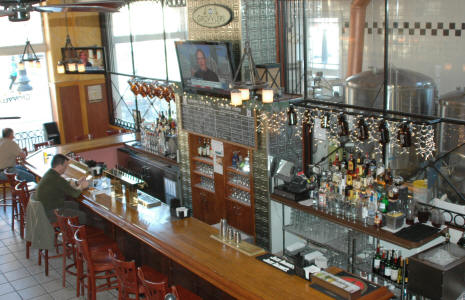
http://www.growlersgastropub.com
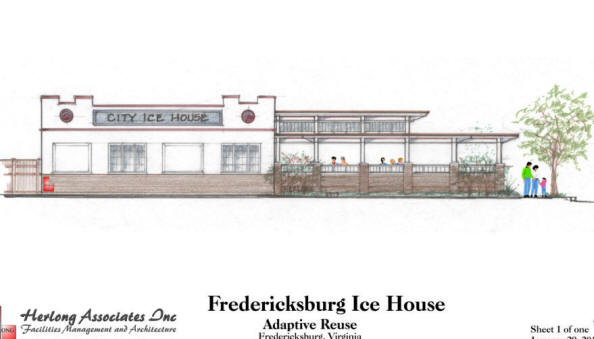
Above, is a concept
rendering, side elevation of the property as a Brew-Pub, or microbrewery, or
just a restaurant.
The main brick
building has no insulation on
the walls or ceiling (except the cold box). Walls are exposed brick. Wood rafters support
a flat roof, maybe skylights in future.
The building can be easily adapted to office, retail, a
combination thereof and/or other uses. The main building features large
windows that can be used or covered over.
Adaptive Reuse
Double click
thumbnails to enlarge



Adaptive reuse is a win-win for everyone. The
owner gets a property at a price less than what it would cost to being in a
vacant lot in suburbia; the neighborhood is revitalized; local, state and
federal governments benefit from taxes generated from increased economic
activity.
Above, at the top of the
web page is a side elevation rendering.
A photo of the existing
conditions is followed by a front elevation rendering and concept of a layout.
Overall, the concept is to
use the land in front of the building. This concept features a patio with
a large overhead trellis, which might become an enclosed heated/air conditioned
space in the future. It is estimated that area is about 2,500 sq. ft. in size
and would greatly increase the square footage to a total of about 7,500 sq. ft.
HOWEVER: in contemplation of removing cold box area and loading docks to
create more off-street parking.
The layout shows about 30+
parking spaces. Further refinement of the layout can accommodate how the
loading dock would articulate to the new parking lot.
The architectural
renderings illustrate concepts that require further research, analysis and
change to comport to zoning and building codes.
Recognition and thanks to the Environmental
Protection Agency for the brownfields grant; The City of Fredericksburg
Department of Economic Development and Tourism, One Environment Group (Richmond,
VA), and Herlong and Associates, architects (Fredericksburg, VA).
Ice Plant Community:
neighborhood
·
The Ice Plant is the worst building on the block;
·
Change the Subject property and the neighborhood
changes as well;
Overall
City
·
Fredericksburg is a vibrant, active, prosperous
city;
·
The City has a documented history of strong civic
pride not just within its own borders, but amongst the outlying area residents
who view the City as the crown jewel of the region and as much a part of their
culture and lives as their own backyards;
·
Largest employers in the Planning District 16 area
of four counties and the City are found within a mile of the Subject property:
Mary Washington Hospital and the University of Mary Washington;
·
The City has an economic development and tourism
organization that is strong, creative, very active and a documented
history of producing tangible results;
See Demographics at the first web
page for population and income figures.


Ice Plant Market
·
The nearest existing microbrewery is the Blue/Gray at an industrial park in
Spotsylvania County; Subject location is superior;
·
The Commonwealth of Virginia passed laws allowing
breweries to sell their beer on site or off premises; thus, creating a huge
marketing channel for the sale of product and branding;
o
Local produce, local processing, mostly local
consumption, along with tourists = sustainability;
o
Community pride is another benefit, if the
entrepreneur invests in and succeeds in building relationships with the
community;
See the information on Demographics at the first
page of this property
o
A local brewery can gain a community following as
strong as a sports team;
o
Tie into the Oktoberfest that is a huge success in
Fredericksburg;
·
As noted, previously, demographics are very
favorable, combined with location near major employment generators and
transportation arteries;
How Can a Microbrewery Grow Your Local
Economy?
Thursday, January 10
2:30 - 4:00 pm EST
Everybody's into "buying local" nowadays. Why should your beer be any
different?
Microbreweries offer substantial opportunities for communities. Not only do
they allow for re-using vacant space, they also create local jobs; attract new
companies or expand existing ones; and increase the tax base. In IEDC's first
web seminar of 2013, you will hear the academic, professional, and practitioner
perspectives on how microbreweries help grow their local economies.
One of several recent academic studies on the economic impact of
microbreweries was completed by Scott Metzger of the University of Texas-San
Antonio. Scott completed the study on behalf of the Texas Craft Brewers Guild,
where he is also a member of their Board of Directors. Scott, in addition to
being a well-respected economist, is also the owner of the popular
Freetail Brewing Co. in San Antonio.
He will share with attendees his extensive knowledge related to the economic
development impact of microbreweries, experiences opening a brewery, as well as
his advice for how best to nurture microbreweries in your community.
Our second speaker will provide the economic developer perspective. Ben
Teague, Senior Vice President of the Asheville Area Chamber of Commerce and
Executive Director of the Asheville, NC-based
Asheville Economic Development Coalition
has years of experience working with microbreweries in his community. Asheville,
NC, current holder of the title 'Beer City USA,' is home to 11 microbreweries.
They also recently secured deals with larger craft brewers New Belgium Brewery
(Colorado), Sierra Nevada Brewing Co. (California), and Oskar Blues Brewery
(Colorado) to invest hundreds of millions dollars in the Asheville-Buncombe
County region of North Carolina. Ben has previously been a featured speaker on
the subject of microbreweries and will share with participants his experience in
working with local microbrewers and larger craft breweries and the impact they
can have on the broader community.
• Hear from the perspective of a microbrewer, the steps that an economic
development professional can take to attract and support microbreweries to their
community.
• Learn from detailed new data that supports the strong economic impact of
microbreweries, including growth potential, job creation, and growth in tax
revenue.
• Understand the importance of place-making in nurturing microbrewery growth
and how to capitalize on the success of microbreweries in your community.
• See how buzz created from local breweries can impact everything from
tourism to research at your local university; lessons learned by our experts can
help you as you explore microbreweries potential in your community or look to
capitalize on those already pouring pints and growlers.

Craft Brewing
Facts
- Craft brewers currently provide an
estimated 103,585 jobs in the U.S.,
including serving staff in brewpubs.
- Growth of the craft brewing industry
in 2011 was 13% by volume and 15% by
dollars compared to growth in 2010 of
12% by volume and 15% by dollars.
- Craft brewers sold an estimated
11,468,152 barrels* of beer in 2011, up
from 10,133,571 in 2010.
- The craft brewing sales share in
2011 was 5.7% by volume and 9.1% by
dollars.
- Craft brewer retail dollar value in
2011 was an estimated $8.7 billion, up
from $7.6 billion in 2010.
- As of March 26, 2012, the Brewers
Association is aware of 250 brewery
openings in 2011 (174 microbreweries and
76 brewpubs) and 37 brewery closings (12
microbreweries and 25 brewpubs).
- 1,940 craft breweries operated for
some or all of 2011, comprised of 1,063
brewpubs, 789 microbreweries and 88
regional craft breweries.
Other U.S. Brewing Industry Facts
- Overall U.S. beer sales were down an
estimated 1.3% by volume in 2011, 1.2%
in 2010.
- Imported beer sales were up 1% in
2011 and up 5% in 2010.
- Overall U.S. beer sales were
approximately 199,937,239 barrels and
imported beer sales were 27,238,339
barrels in 2010.
- 1,989 total breweries operated for
some or all of 2011, the highest total
since the 1880s.
* 1 barrel = 31 US gallons Last updated on 3/26/2012
Source:
http://www.brewersassociation.org/pages/business-tools/craft-brewing-statistics/facts
An
Excellent Source:
American Brewers Association . Org
2011
Craft
Beer
Industry
-
Growth
of
the
craft
brewing
industry
in
2011
was
13%
by
volume
and
15%
by
retail
dollars.
2011
Craft
Beer
Industry
Production
Volume
| Regional craft breweries |
9,029,607 bbl |
| Contract brewing companies |
228,504 bbl |
| Microbreweries |
1,441,505 bbl |
| Brewpubs |
768,536 bbl |
Domestic
Craft
Beer
Sales
| 2011 |
11,468,152 barrels |
| 2010 |
10,133,571 barrels |
How big
is the
US beer
market?
Overall
US Beer
Market
in 2011:
-
Down
1%
-
Approximately
$96
billion
-
Selling
199,937,239
barrels
of
beer.
Where:
-
1
barrel
= 31
US
gallons
-
31
US
gallons
= 2
half-barrels
-
2
half-barrels
(15.5
gallon)
kegs
=
13.78
cases
(of
24
12-ounce
bottles).
See
Craft
Brewer
Defined
for more
details
on
industry
definitions.
Update:
Brewers
Association
Reports
2012
Mid-Year
Growth
For U.S.
Craft
Brewers
Important
Information
Media
should
contact
Paul
Gatza,
Julia
Herz,
or
Barbara
Fusco
at the
Brewers
Association
for more
information.
1.888.822.6273
or
+1303.447.0816.
Comprehensive
reports
and
analysis
will be
printed
in the
May/June
issue of
The
New
Brewer,
The
Journal
of the
Brewers
Association,
released
in
mid-May
each
year.
The
issue
can be
purchased
directly
from the
Brewers
Association
by
calling
1.888.822.6273,
+1.303.447.0816.
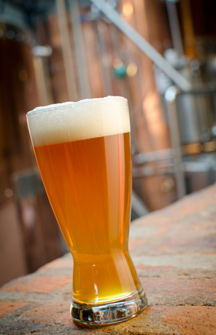 An American craft brewer is small, independent and traditional. An American craft brewer is small, independent and traditional.Small: Annual production of 6 million barrels of beer or less. Beer production is attributed to a brewer according to the rules of alternating proprietorships. Flavored malt beverages are not considered beer for purposes of this definition.
Independent: Less than 25% of the craft brewery is owned or controlled (or equivalent economic interest) by an alcoholic beverage industry member who is not themselves a craft brewer.
Traditional: A brewer who has either an all malt flagship (the beer which represents the greatest volume among that brewers brands) or has at least 50% of its volume in either all malt beers or in beers which use adjuncts to enhance rather than lighten flavor.
The following are some concepts related to craft beer and craft brewers:
- Craft brewers are small brewers.
- The hallmark of craft beer and craft brewers is innovation. Craft brewers interpret historic styles with unique twists and develop new styles that have no precedent.
- Craft beer is generally made with traditional ingredients like malted barley; interesting and sometimes non-traditional ingredients are often added for distinctiveness.
- Craft brewers tend to be very involved in their communities through philanthropy, product donations, volunteerism, and sponsorship of events.
- Craft brewers have distinctive, individualistic approaches to connecting with their customers.
- Craft brewers maintain integrity by what they brew and their general independence, free from a substantial interest by a non-craft brewer.
- The majority of Americans live within ten miles of a craft brewer.
Please
note:
Owner is
a
licensed
real
estate
agent in
Virginia.
Notice: Purchaser
is cautioned and urged to investigate any and all information and
circumstances. Information contained in this web site and links is not
guaranteed in terms of accuracy and/or scope.
Mr. Alex Long,
CCIM, AICP, ALC
along@ccim.net
540.371.8700
Licensed in Virginia
"CCIM"
Certified Commercial Investment Member; "AICP"
American Institute of Certified Planners, American Planning Association;
"ALC" Accredited Land Consultant, Realtor Land
Institute.
Weichert Realtors; 1955
Jefferson Davis Highway, Suite 201; Fredericksburg, VA. 22401
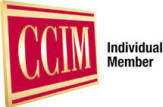
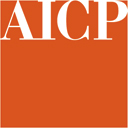

 |
 An American craft brewer is small, independent and traditional.
An American craft brewer is small, independent and traditional.



 At left, Williamsburg Ale Works; a tour taking place
At left, Williamsburg Ale Works; a tour taking place









